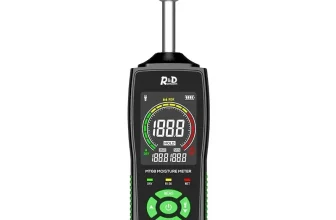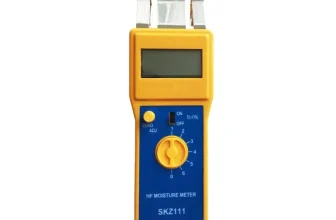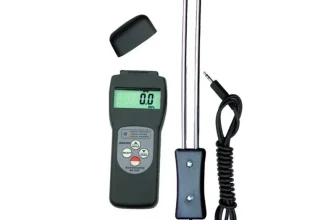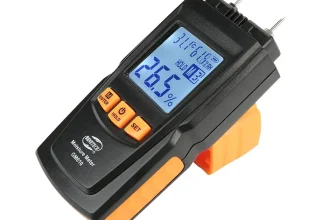A Hay moisture monitor is a specialized device employed by farmers,
hay producers, and the agricultural community as a whole to accurately
determine the moisture content of hay. It is specifically designed to
measure, monitor, and assess the moisture levels in both baled and loose
hay, to ensure that it is at a safe and optimal degree for storage and
use. A correct appraisal of moisture content is integral for maintaining
the quality and nutritional value of hay, and to avoid potential hazards
such as spontaneous combustion of overly moist hay. This monitoring tool
supports a sustainable and efficient farming practice by aiding in the
prevention of hay material degradation, loss of nutrients, and unwanted
agricultural incidents.
Importance of
hay moisture measurement in farming
Measuring the moisture content of hay in farming is of paramount
importance. This is largely due to its significant influence on both the
quality of the hay produced and the safety of its storage. By
controlling moisture levels, farmers can ensure that their fodder
retains the maximum possible nutrient value, crucial for the health and
productivity of their livestock. Proper moisture management effectively
prevents the devastating occurrence of hay fires, which tend to result
from excessive moisture, posing a risk to both property and lives. The
prevention of mold growth, which could cause respiratory illnesses in
animals, is another critical benefit of keeping hay moisture in check.
Therefore, the use of accurate and reliable equipment such as a hay
moisture monitor becomes a key element for successful and safe farming
practices.
Detailed
Understanding of a Hay Moisture Monitor
What is a Hay Moisture
Monitor
Definition
A hay moisture monitor, also often referred to as a hay moisture
tester or meter, is a specialized agricultural device designed to
accurately measure the moisture content within a haystack. This
sophisticated technology essentially gauges the percentage of water
present in the hay at any given moment, allowing farmers to ascertain if
the hay is ready for use in various applications, such as baling,
storage, or feeding. Monitoring the moisture content of hay allows
farmers to maintain optimal conditions to preserve the nutritional
quality of the hay and minimize the risk of spoilage, mold development,
and even potential fire hazards. In essence, a hay moisture monitor is a
vital tool in precision farming, paving the way for enhanced
effectiveness and efficiency in agricultural practices.
Components of a hay
moisture monitor
A hay moisture monitor, as the name suggests, is a device
specifically designed and engineered to assess the moisture content in
hay. The fundamental components of a standard hay moisture monitor
include a digital or analog display, a probe or sensor, and a power
source, usually a battery.
The display is typically easy to read and interprets the readings
from the probe or sensor into a percentage that indicates the moisture
level present in the hay. This percentage can then be used to make
informed decisions regarding various aspects of hay management, from
baling to storage.
The probe, which is arguably the most vital component of the monitor,
is inserted directly into the hay. The sensors on the probe then measure
the moisture in the material. Probes can vary in length and design
depending on the type of monitor, but the primary function of accurately
gauging moisture remains the same.
Lastly, to function effectively in field conditions, hay moisture
monitors are usually powered by standard or rechargeable batteries. Some
monitors come with a low-battery indicator, allowing for timely battery
replacements to avoid inaccurate readings.
In sum, while the design and specifics may vary among different
brands and models, a hay moisture monitor primarily consists of a
moisture-sensing probe, a display to relay the moisture percentage, and
a power source to run the device. These essential components work in
harmony to deliver a practical and necessary tool for farmers and anyone
involved in the production and management of hay.
How a Hay Moisture Monitor
Works
Process of measuring
moisture
A hay moisture monitor operates on the principal of electrical
conductivity and resistance which changes with variations in moisture
content. The tool contains probes or sensors that are inserted into the
bale or windrow of hay. These probes create an electrical field, which
is impacted by the amount of moisture within the hay.
The wetter the hay, the less resistance there is to the electricity
passing between the probes, hence the electrical conductivity increases.
Conversely, drier hay will produce a higher resistance and thereby
decrease conductivity. The device then takes this data, processes it
through specialized algorithms within the built-in microprocessor and
presents a reading of the moisture percentage on the monitor’s
display.
The reading is almost instant, generally taken in a matter of
seconds, allowing regular and comprehensive testing to be undergone as
the bailing process continues without substantial interruption. This
ensures a more consistent and reliable moisture content in the hay
bales.
Interpretation of results
Interpreting the results provided by a hay moisture monitor is a
crucial step in the process. Once the moisture has been measured, it is
usually displayed on the device’s screen or digital interface in the
form of a percentage. This is a direct reflection of the moisture level
present within the hay.
The range of acceptable moisture levels can vary depending on various
factors. However, generally, for baled hay, the safe moisture content is
considered to be between 15% and 20%.
If the moisture content is below 15%, the hay may be overly dry. This
can lead to an increased probability of leaf loss, reducing the
nutritional value of the hay. On the other hand, if the moisture level
exceeds 20%, it suggests that the hay is too wet. Baling and storing hay
in this state can cause major problems such as microbial growth, heating
in the bale, and even spontaneous combustion.
It’s important to note that the moisture thresholds can vary,
particularly depending on the species of plant, the specific climate,
and the techniques employed for storage. Therefore, it’s vital to
understand the specific requirements of your particular farming
situation to make accurate interpretations. Familiarity with these
aspects will allow farmers to take immediate action such as adjusting
the drying process or the timing of baling, and ultimately ensure a
better yield and quality of the harvested hay.
Significance of Hay
Moisture Monitoring
Importance in Bale Quality
Influence on bale density
Monitoring hay moisture is integral in maintaining bale quality,
especially when considering the influence it has on bale density. The
relationship between moisture content and the density of a bale is
direct and often crucial in determining the longevity and quality of
stored hay.
When hay is baled at the right moisture level, typically between
15-20%, it allows compaction into dense bales with less air space. The
bales retain this density as they dry, which is beneficial in preventing
the loss of leaves, a key source of nutrients.
Alternatively, hay baled with excessive moisture is harder to compact
effectively. It springs back after baling, resulting in an increased air
space that paves the way for microbial activity. These microbes draw on
the nutrients in the hay causing a decrease in its overall quality.
Meanwhile, baling hay that’s too dry can also impact bale density
negatively. The brittle and stiff plant material does not compact well,
leading to loose bales that may further lead to losses through reduced
transportation efficiency and greater vulnerability to weather.
Thus, by utilising a hay moisture monitor to ensure the correct
moisture levels, farmers can enhance bale density and subsequently the
overall quality of their hay.
Impact on nutrient
preservation
Proper moisture levels in hay are not only important for maintaining
high-quality bale density, but they also play a critical role in
preserving vital nutrients. When hay is baled at the correct moisture
levels, it ensures the preservation of essential elements such as
proteins, carbohydrates, minerals, and vitamins which are crucial for
the animals’ diet.
Hay baled with excessively high moisture content, on the other hand,
can lead to significant nutrient loss due to microbial activity. The
surplus moisture serves as a breeding ground for harmful microbes,
including mold and bacteria that lead to nutrient degradation, thus
reducing the quality of the hay.
Equally, hay that is too dry can also result in nutrient loss, albeit
through a different mechanism. When the hay is overly dry, leaves become
brittle and tend to shatter during the baling process. Since the
majority of the nutrients in hay are found in the leaves rather than the
stems, this leaf loss greatly reduces the overall nutritional value of
the bale.
In essence, monitoring and maintaining the ideal hay moisture level
is akin to protecting the nutritional investment in the hay, ensuring
animals are fed with high-quality, nutrient-rich fodder. This
contributes to better animal health and productivity, underlining the
critical role hay moisture monitors play in preserving nutrients in
baled hay.
Importance in Preventing Hay
Fires
Relationship
between moisture and combustibility
Understanding the relationship between moisture content and
combustibility in hay is crucial in preventing hay fires. When hay is
baled at a moisture level higher than recommended, the chances of a
spontaneous fire drastically increase. Here’s why: excess moisture
stimulates bacterial growth within the hay, as the bacteria break down
the hay, they generate heat.
Under normal conditions, this heat dissipates into the environment
and does not pose a problem. However, when the hay is densely packed
into bales, the heat can get trapped. If the internal temperature of the
bale rises high enough, it can ignite the dry material within the hay,
resulting in a fire.
By now, it should be clear why moisture is such a critical parameter
when it comes to hay storage safety. Monitoring and managing the
moisture content before baling hay provides the best protection against
the risk of spontaneous combustion and the devastating losses a fire can
bring. Therefore, using a hay moisture monitor becomes an essential tool
in preventive agricultural practices.
Historical
incidents of hay fires due to incorrect moisture levels
Most would not immediately identify freshly stored hay as a potential
fire hazard, however, the unfortunate reality is that hay fires have
caused significant damage and financial loss throughout history due to
incorrect moisture levels.
Take, for instance, the unfortunate event from July 1977 in
Schenectady, New York, wherein nearly $2 million worth of hay burned due
to improper moisture content. Or the more recent 2009 case in South
Dakota, where a farmer lost around 2,000 bales of hay because moisture
levels were too high when the hay was baled and stored.
In 2012, Texas A&M AgriLife Extension Service reported a series
of hay fires across the state. Following analysis, it was determined
that all the fires had one thing in common – hay baled at high moisture
levels. These incidents resulted in severe loss of valuable feed and
considerable fire department resources.
These incidents serve as sharp reminders to farmers cautioning them
about the risks associated with incorrect moisture in hay. It
underscores the need for reliant, accurate, and comprehensive monitoring
of hay moisture levels to prevent such disastrous events in the
future.
Different Types of Hay
Moisture Monitors
Portable Monitors
Portable hay moisture monitors, as the name suggests, are compact and
lightweight devices that can be easily carried around the farm. These
handheld instruments are the perfect tools for quick, on-the-spot
moisture testing of the hay. They are typically equipped with a digital
display and a probe that is inserted into the bale to read the moisture
content.
One of the most significant advantages of portable monitors is their
convenience and flexibility. Farmers can use them at various stages of
hay production, from the windrowing stage before baling to checking the
moisture content of the stored bales. This type of monitor often
features an adjustable probe length designed to penetrate deep into the
bale for a more accurate reading.
Despite being smaller in size, most portable hay moisture monitors do
not compromise on precision. They offer high degrees of accuracy, which
is crucial in ensuring the optimum quality of the hay.
However, it’s crucial to be aware that the readings from portable
monitors can sometimes be influenced by external environmental factors
such as temperature and humidity. Therefore, regular calibration and
occasional cross-reference with other types of monitors might be
necessary for maintaining the accuracy of these devices.
In conclusion, portable hay moisture monitors are excellent tools for
farmers looking to quickly and conveniently ensure that their hay bales
are kept at the ideal moisture levels to prevent spoilage and potential
fire hazards.
Fixed/Stationary Monitors
Fixed or Stationary Hay Moisture Monitors are typically designed for
use during hay packaging processes. These permanent fixtures can be
directly mounted onto balers or other hay processing machinery. Being an
integral part of the baling operation, they consistently provide
moisture readings without any work disruption.
The main advantage of fixed monitors lies in their ability to give
real-time moisture content readouts as hay is being processed. This way,
immediate actions can be taken for any undesirable moisture readings.
They often come equipped with advanced features such as alarms or
indicators to notify the user of any readings beyond certain setpoints.
Some even have data storage capabilities to record moisture levels over
time, giving farmers insights into trends and changes in hay moisture
content.
While fixed monitors significantly aid in achieving optimal bale
moisture levels, one small drawbacks to consider is their initial
installation, which can need some technical understanding. However, once
it’s done, these monitors can provide years of reliable service. Their
durability and resistance to the demanding conditions of farming
environment make them a valuable long-term investment.
In-Line Monitors
In-line monitors are highly efficient types of hay moisture monitors
which are generally used for large-scale operations. They are typically
installed directly on the baling equipment, enabling real-time moisture
reading during the baling process. This gives farmers an immediate
insight into the moisture content of the hay as it’s being baled, which
can significantly enhance efficiency and quality control.
In-line monitors work by sending an electrical current through the
hay as it passes through the baler. The resistance to this current is
then interpreted by the monitor to give a moisture reading, which is
usually displayed on a digital screen mounted within the operator’s line
of sight. This allows for immediate adjustments to be made in case the
moisture content is too high or low, hence preventing substandard bale
formation and the probable occurrence of hay fires.
Though they might come at a higher price point compared to portable
or fixed monitors, in-line monitors offer the advantage of making
continuous measurements. This allows for effective management of the
baling operation and can result in substantial cost savings in the
long-term. Therefore, in-line monitors could be a worthwhile investment
for commercial farmers or those dealing with large volumes of hay.
Factors to
Consider when Choosing a Hay Moisture Monitor
Accuracy
Accuracy is undoubtedly the paramount factor to consider when
choosing a hay moisture monitor. It is absolutely crucial that the
monitor provides precise readings to avoid premature baling which can
lead to spoilage, or baling overly dry hay, which can cause substantial
losses in the total available digestible nutrients. The monitor should
ideally provide accurate results within +/- 1% of the actual moisture
content. Therefore, when selecting a hay moisture monitor, you should
thoroughly check the product specifications to ensure the device offers
superior accuracy. Additionally, look for models validated by reputable
farming and agricultural institutions as these often meet high standards
of measurement accuracy. Bear in mind that inaccuracies in hay moisture
readings can induce significant long-term costs in waste, reduced
farming efficiency, and potential safety risks. Investing in an accurate
moisture measurement tool provides a guarantee for the quality and
safety of your hay.
Durability
Durability is a key factor when choosing a hay moisture monitor.
Farming conditions can often be quite rugged, and any device used must
be able to withstand exposure to the elements without malfunctioning or
breaking down.
A durable hay moisture monitor is one that can resist wear and tear,
making it more cost-effective in the long run. These monitors are
usually encased in tough, weather-resistant material, protecting their
internal components from damage and ensuring they can function optimally
for an extended period.
Furthermore, durability can extend to the monitor’s probe or sensor,
which is consistently inserted into hay to take readings. A robust probe
not only guarantees consistent and precise results but also ensures your
unit stands the test of time, providing longevity and reliable
service.
It is recommended that farmers consider moisture monitors that are
well-reviewed for their durability, paving the way for accurate,
long-term moisture monitoring. As a best practice, investing in a
robust, high-quality monitor often saves the cost and inconvenience of
frequent replacements.
Ease of use
Ease of use is another critical factor to consider when choosing a
hay moisture monitor. This aspect involves understanding how simple and
intuitive it is to operate the device. Firstly, the monitor should have
a user-friendly interface, allowing farmers to implement it into their
routine without hassle. Some models come with digital screens that
display clear, easy-to-understand readings.
Moreover, the ease of calibration is important. The device should
allow for a straightforward calibration process so that farmers can rely
on accurate and consistent readings. An easy-to-use hay moisture monitor
also means a more time-efficient operation as farmers can quickly
measure and evaluate the moisture content of their hay.
Finally, some hay moisture monitors are designed with features such
as backlighting for low light conditions or large, easy-to-read numbers.
These features enhance the practicality of use, particularly in varied
farming conditions. Therefore, when selecting a hay moisture monitor,
consider how easily it can be integrated into your farming operations,
and how user-friendly its features are.
Price
When purchasing a hay moisture monitor, price is an important factor
to consider. These devices can vary significantly in cost, largely
depending on the features it offers. Basic models, which are likely more
suitable for small-scale farmers or hobbyists, are generally at the
lower end of the price scale. However, while these cost-effective models
may cover essential monitoring needs, they might lack advanced features,
such as digital reading, data storage, or hay temperature
measurement.
On the other hand, more expensive models are usually equipped with
advanced technologies that offer more precise readings and additional
functionalities, which prove beneficial for larger agricultural
enterprises. These may also come with software for data management and
analysis or wireless capabilities for remote monitoring.
It’s essential to bear in mind that while the initial cost of these
advanced moisture monitors might seem steep, the long-term benefits they
offer in maintaining hay quality and reducing the risk of losses due to
mold growth or spontaneous combustion can offset the initial investment
over time. Therefore, when considering the price of a hay moisture
monitor, it is crucial to not just focus on the upfront cost but also on
the value it provides in the long run.
Remember, the cheapest device will not necessarily save you money if
it is inaccurate, unreliable or doesn’t meet your specific needs.
Selecting a moisture monitor is an investment in your farm’s
productivity and safety, so choose wisely.
Conclusion
Reiteration
of the importance of hay moisture monitoring
Harvesting hay of the right moisture content is integral to the
farming industry. It not only ensures optimal bale quality with a high
nutrient preservation but also significantly reduces the risk of
devastating hay fires. By providing real-time and accurate moisture
content readings, hay moisture monitors have revolutionized the way we
harvest hay. They are a smart investment, which aid in avoiding losses
from poor hay quality and spontaneous combustion. Thus, it’s undeniable
that incorporating this modern technology into farming practices
contributes significantly to productive and safer farming.
Encouraging
readers to adopt best farming practices using modern technology
Hay moisture monitoring is an integral part of modern farming that
can’t be overlooked. The tool goes beyond just gauging the water level
in your hay. It’s also about ensuring the quality and safety of your
bales, mitigating the risk of hay fires, and ultimately, preserving the
nutritional value of your forage. Investing in a reliable hay moisture
monitor presents a great opportunity to enhance your farming operations
through the use of technology.
In the rapidly evolving world of farming, it is crucial to stay
up-to-date and incorporate innovative tools and technology for optimum
productivity and safety. We implore all readers and farmers to not only
see hay moisture monitoring as a mere task but as an essential practice
that promotes sustainable farming. Factor it into your routine and
witness the improvements technology can bring to your farming business,
ensuring you get the best out of your agricultural endeavors.







